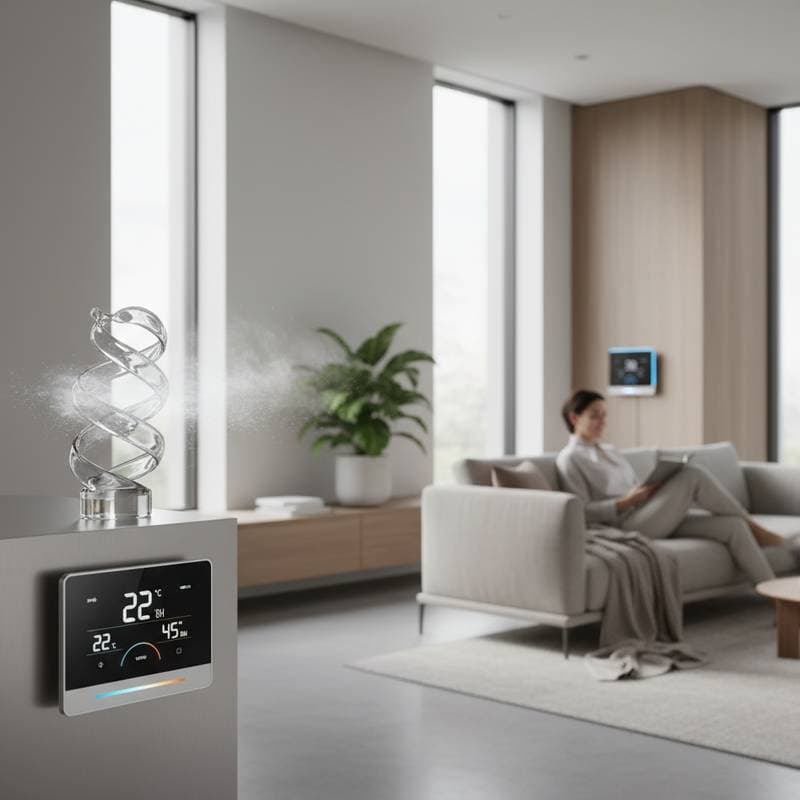The Role of Humidity in Modern Home Comfort
Humidity levels influence indoor environments more than many homeowners realize. In 2025, advanced HVAC systems address this by integrating precise moisture regulation alongside temperature control. These technologies ensure air remains comfortable without excessive dryness or dampness, which directly impacts daily living.
Excessive humidity fosters discomfort, promotes mold growth, and strains HVAC equipment. Conversely, low humidity leads to dry skin, static electricity, and structural damage to wooden elements. Balanced humidity, typically between 30 and 50 percent, creates an environment where air circulation feels natural and refreshing.
Homeowners benefit from systems that adapt to local climates. For instance, in humid regions, dehumidification prevents overload on air conditioners. In drier areas, humidifiers maintain moisture to avoid irritation. This targeted approach elevates overall satisfaction.
Key Innovations in 2025 HVAC Humidity Control
Technological advancements make humidity management seamless. Smart thermostats now monitor and adjust moisture levels in real time, using sensors to respond to occupancy and weather changes. Whole-home dehumidifiers integrate directly into ductwork, pulling excess moisture from the air as it circulates.
Portable units offer flexibility for specific rooms, while standalone humidifiers suit targeted needs. Energy-efficient models incorporate variable-speed fans that operate quietly and consume less power. These features align with 2025 trends toward sustainable, connected homes.
Integration with existing HVAC setups minimizes disruption. Many systems pair with zoning controls, allowing customized humidity in different areas like bedrooms or basements. This precision reduces energy waste and enhances uniformity.
Practical Considerations for Installation and Costs
Investing in humidity control requires planning. Whole-home dehumidifiers generally cost between $1,000 and $2,500 for installation, depending on unit size and home layout. Integrated humidifiers range from $500 to $1,500, influenced by capacity and compatibility with current systems.
Energy savings provide a strong return. Proper humidity balance lowers heating and cooling demands, potentially reducing annual bills by 10 to 20 percent. Systems that prevent moisture buildup also decrease wear on HVAC components, extending equipment life by years.
Safety remains paramount. Engage licensed professionals who adhere to local building codes. Incorrect installation risks condensation within ducts or electrical issues. Most projects complete in one day, though combining with routine maintenance streamlines the process.
Assess your home's specifics before proceeding. Factors such as square footage, insulation quality, and regional climate guide the best choice. A consultation ensures the system aligns with your setup for maximum effectiveness.
Creating a Healthier Home Through Moisture Management
Effective humidity control extends to health and home preservation. Stable moisture levels support respiratory well-being by minimizing allergens and irritants. Reduced dust mites and mold lower the risk of allergies and infections.
Structural integrity benefits as well. Excess moisture warps wood and promotes rot, while dryness causes cracking in floors and furniture. Balanced air preserves these elements, maintaining aesthetic appeal over time.
Daily experiences improve noticeably. Air circulation feels invigorating, surfaces remain dust-free, and HVAC units operate without strain. This quiet efficiency fosters a serene living space protected from environmental stresses.
Frequently Asked Questions
How can you identify unbalanced humidity in your home?
Signs of high humidity include window condensation, musty odors, or a clammy sensation in summer. Low humidity manifests as static electricity, dry skin, or chapped lips in winter. Purchase a hygrometer for less than $30 to measure levels precisely.
Is it necessary to use a dehumidifier alongside an air conditioner?
In humid climates, yes. Air conditioners remove some moisture, but a dedicated dehumidifier amplifies comfort and eases system workload. It maintains steady levels even during mild cooling periods.
What maintenance does a humidity control system require?
Regular filter changes and annual inspections keep units efficient. Clean coils prevent buildup, and check drains to avoid water issues. Professional servicing ensures longevity and performance.
Can humidity control improve sleep quality?
Absolutely. Optimal levels reduce nighttime discomfort from dryness or stuffiness, promoting better rest. Many systems include sleep modes that adjust automatically.
Steps to Achieve Balanced Indoor Air
Begin by evaluating your current setup. Measure humidity with a reliable device and note any discomfort signs. Consult a certified technician to review your HVAC system and recommend tailored solutions.
Schedule installation during off-peak seasons to minimize inconvenience. Post-installation, monitor adjustments and tweak settings for preference. These steps secure lasting comfort and efficiency.
As an HVAC specialist, prioritize partnering with experienced professionals who account for your local climate and home design. They deliver systems optimized for your needs, ensuring enhanced air quality and reduced operational costs.



